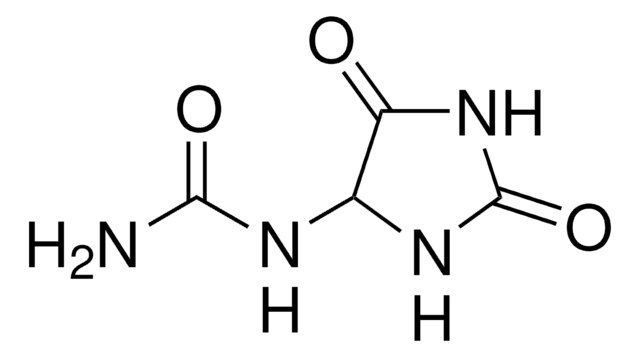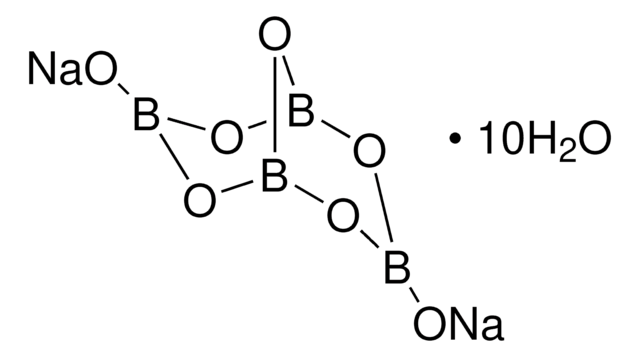B0394
Borsäure
ACS reagent, ≥99.5%
About This Item
Empfohlene Produkte
Qualität
ACS reagent
Qualitätsniveau
Agentur
suitable for SM 4500 - NH3
suitable for SM 5210
Dampfdruck
2.6 mmHg ( 20 °C)
Assay
≥99.5%
Form
powder
Methode(n)
PCR: suitable
Verunreinigungen
≤0.005% Insoluble in methanol
≤0.05% Nonvolatile with methanol
mp (Schmelzpunkt)
160 °C (dec.) (lit.)
Löslichkeit
water: soluble
Dichte
1.440 g/cm3
Anionenspuren
chloride (Cl-): ≤0.001%
phosphate (PO43-): ≤0.001%
sulfate (SO42-): ≤0.01%
Kationenspuren
Ca: ≤0.005%
Fe: ≤0.001%
heavy metals: ≤0.001% (by ICP)
SMILES String
OB(O)O
InChI
1S/BH3O3/c2-1(3)4/h2-4H
InChIKey
KGBXLFKZBHKPEV-UHFFFAOYSA-N
Suchen Sie nach ähnlichen Produkten? Aufrufen Leitfaden zum Produktvergleich
Allgemeine Beschreibung
Anwendung
- N-substituierte Cinnamamide über eine Amidierungsreaktion zwischen Zimtsäure und Benzylaminen.
- β-Aminoalkohole durch die regioselektive Epoxid-Ringöffnung mit aromatischen Aminen in Gegenwart von Glycerin als Co-Katalysator.
- Organoschwefelverbindungen durch thia-Michael-Addition von Thiolen an α, β-ungesättigte Verbindungen.
Signalwort
Danger
H-Sätze
Gefahreneinstufungen
Repr. 1B
Lagerklassenschlüssel
6.1D - Non-combustible acute toxic Cat.3 / toxic hazardous materials or hazardous materials causing chronic effects
WGK
WGK 1
Flammpunkt (°F)
Not applicable
Flammpunkt (°C)
Not applicable
Analysenzertifikate (COA)
Suchen Sie nach Analysenzertifikate (COA), indem Sie die Lot-/Chargennummer des Produkts eingeben. Lot- und Chargennummern sind auf dem Produktetikett hinter den Wörtern ‘Lot’ oder ‘Batch’ (Lot oder Charge) zu finden.
Besitzen Sie dieses Produkt bereits?
In der Dokumentenbibliothek finden Sie die Dokumentation zu den Produkten, die Sie kürzlich erworben haben.
Kunden haben sich ebenfalls angesehen
Artikel
Information on Isoelectric Focusing including what it is and how it is used. In order to ensure the high performance of analysis, isoelectric point (pI) standards are needed.
Information on Isoelectric Focusing including what it is and how it is used. In order to ensure the high performance of analysis, isoelectric point (pI) standards are needed.
Unser Team von Wissenschaftlern verfügt über Erfahrung in allen Forschungsbereichen einschließlich Life Science, Materialwissenschaften, chemischer Synthese, Chromatographie, Analytik und vielen mehr..
Setzen Sie sich mit dem technischen Dienst in Verbindung.







